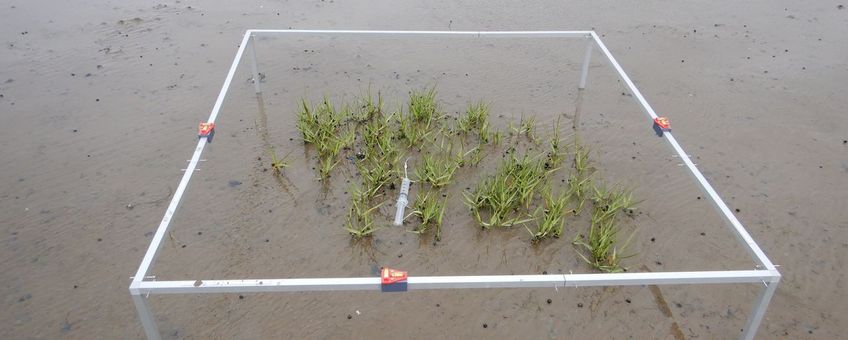
Cordgrass spreads the risk
NIOZ Royal Netherlands Institute for Sea ResearchOnce they grow bigger, the plants themselves dampen the stress from the environment by trapping sediment and slowing down waves and currents. By spreading further and capturing sediment, they literally grow above the danger zone. 'This kind of fundamental knowledge about how plants establish themselves in a new environment can help us protect and restore valuable salt marshes', said Van de Ven.
From Denmark to France
For her research, Van de Ven and colleagues visited salt marshes and dunes from Denmark to France. In several places they mapped exactly how young plants spread in the environment. Van de Ven: 'The small cordgrass plants thus appear to grow in clusters, allowing water to flow between the clusters with relatively little resistance. This way of growing reduces the risk of being washed away or damaged in the extremely dynamic environment of tidal wetlands. Only when they have grown larger, new shoots fill the space between clusters, slowing down the current and dampening the impact of waves. At that point, the plants also begin to trap sand or silt, literally raising their immediate environment. In this way, they grow out of the danger zone, so waves and currents have less control over them.'


Plants with a strategy
Van de Ven talks about the plants as if they are making rational decisions. Yet, she must acknowledge that it is still unclear what mechanisms are behind these ‘decisions’. 'It may be an evolutionary, and therefore hereditary mechanism. At the same time, it could also be that plants that happen to do things differently just don't survive. But it was striking to find that young plants also grow in clusters in very calm conditions when they are not yet directly exposed to stress. So, in one way or another, it does seem to be a widespread growth strategy to avoid risk in the future.'
Practical application
The knowledge about growth and spreading of young plants on salt marshes can also have a practical application, Van de Ven believes. 'Coastal ecosystems such as salt marshes are not only valuable ecosystems for biodiversity. These systems can also protect our coasts from rising sea levels. If we want to work on restoring natural coastal protection, we will need to understand how the first plants in such a new system will have the best chance to establish.'
Text and photo's: Koninklijk Nederlands Instituut voor Onderzoek der Zee (NIOZ) (lead photo: An established cordgrass plant with several clusters with a number of shoots in the middle of a measurement frame)
